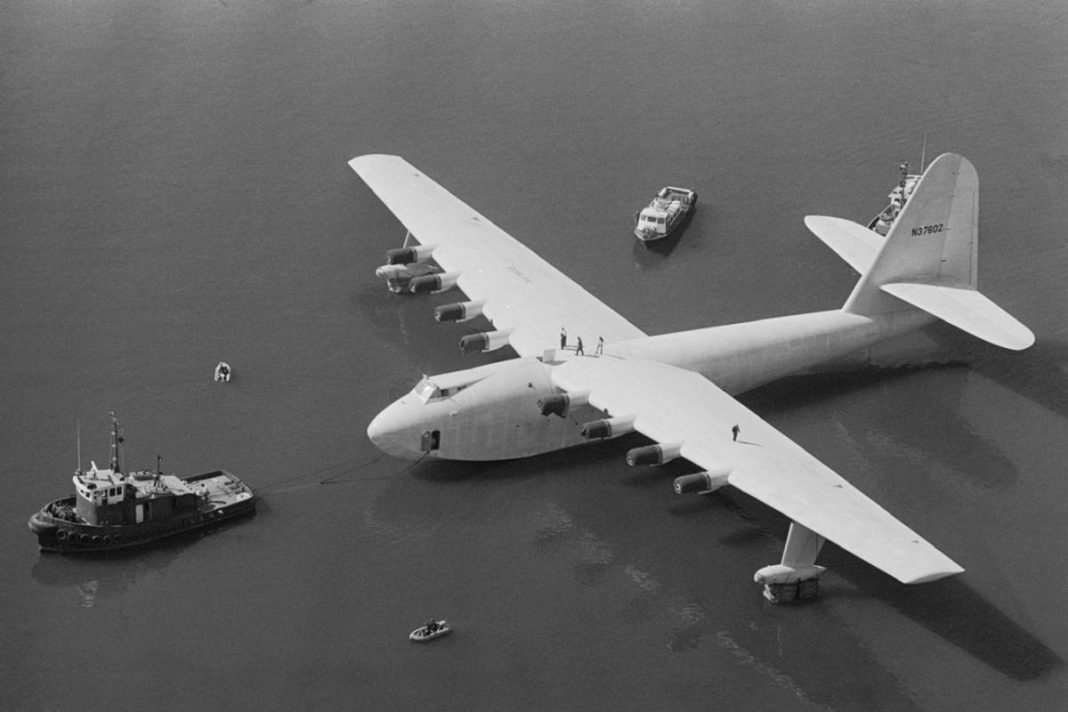Howard Hughes was one of the most prominent figures in aviation over the first half of the 20th century. He broke ground as a pilot, engineer, businessman, and movie producer. One of the most ambitious projects that the pioneer was behind was the H-4 Hercules aircraft.

Big responsibilities
The H-4 Hercules was an absolute behemoth of a unit. It was a 400,000-pound (181,436-kilogram) flying boat and was the largest one ever built with the widest wingspan.
At the end of the 1930s, Hughes used his holdings to buy a controlling stake in Trans World Airlines (TWA). However, the United States soon started to prioritize its workforce for the World War II effort.
Therefore, TWA’s planes were used to support the US military. Alongside this move, Hughes’ other developments, such as H-4 Hercules, were billed to be used for the war. The government wanted to use it as a cargo and troop carrier that would not be susceptible to Axis submarines.
Additionally, by substituting wood for metal in its production, the aircraft would not use critical wartime resources. However, it was not completed until after the conflict was over, despite Hughes’ company being contracted by officials.
The plane was initially conceived by Henry J. Kaiser, a steelmaker, and builder of Liberty ships. However, he withdrew his support for the project in 1944.
A significant task
The plane did not come to fruition until 1947 and went on to be known as the Spruce Goose, which was an eight-engine wooden flying boat. Hughes detested this name as he felt it insulted the workers on the aircraft. Moreover, the construction was built almost entirely of laminated birch, and not spruce.

The H-4 Hercules was designed to carry 750 fully equipped troops or two Sherman tanks during long-distance operations. Boeing highlights that the plane had a single hull, eight radial engines, and a single vertical tail. Furthermore, it had fixed wingtip floats, along with a full cantilever wing and tail surfaces.
The whole airframe and surface structures were made of laminated wood. Meanwhile, all primary control surfaces, apart from the flaps, were covered in fabric. Moreover, a flight deck for the crew and a significant cargo hold was in the hull.
Official concerns
Subsequently, due to the delay of the plane’s completion, Hughes was brought before a Senate committee over allegations of war profiteering. He went head to head with Senator Owen Brewster and triumphed.
By 1947, the US government had spent $22 million ($572 million today) on the aircraft, and Hughes had spent $18 million ($468 million today) of his own money. According to Bremont, the entrepreneur defended his project and reputation with determination.
“If I made any mistake on this airplane it was not through neglect. It was through supervising each portion of it in too much detail…I am by nature a perfectionist, and I seem to have trouble allowing anything to go through in a half-perfect condition. So if I made any mistake it was in working too hard and in doing too much of it with my own two hands,” Hughes said, as shared by Bremont.
“I put the sweat of my life into this thing. I have my reputation rolled up in it, and I have stated that if it was a failure I probably will leave this country and never come back, and I mean it.”

Showing his intent
Hughes’ did not give up. The fruits of his team’s labor were finally starting to show on November 2nd, 1947. The businessman and a group of engineers lifted the eight radial engines for taxi tests.
The aircraft rose 33 feet (10 meters) off the surface of Long Beach, California’s harbor, and it flew it for one mile (1.6 kilometers). The flying boat remained in the air for less than a minute, and reached 70 feet (21 meters) off the water at a speed of 80 mph (128 km/h) before hitting the surface.
Sadly, the aircraft has not flown since. However, until his passing in April 1976, Hughes ensured that the H-4 Hercules was constantly kept in good condition.
Leaving a legacy
The Aero Club of Southern California subsequently preserved the aircraft in its own circular building, next to the famous Queen Mary ocean liner, at Long Beach. In 1988, The Walt Disney Company took over the area but the firm did not have any interest in the plane.
So, the Aero Club sold it to the Evergreen Aviation Museum (now the Evergreen Aviation & Space Museum) in 1993. The company disassembled the unit and shipped it to McMinnville, Oregon, where it presently lives.

Much like Howard Hughes in his early career, the Los Angles hangar where the H-4 was built has become a feature in Hollywood. Scenes from movies such as The Aviator, Titanic, Avatar, Eagle Eye, and Transformers have been filmed in the 315,000-square-foot space.
At the moment, Google leases the property where the hangar was. The building underwent a transformation into a creative office space when the tech giant moved in at the end of 2018.
Altogether, even though the H-4 Hercules did not serve its original purpose, it has become a symbol of the US aviation industry’s ambition during its growth stage. Had it been ready in time for the Second World War, it would have definitely been an overwhelming sight to see in the skies.
What are your thoughts about Hughes’ H-4 Hercules aircraft? Have you seen the aircraft at any of its locations over the decades? Let us know what you think of the plane in the comment section.
[ad_2]
Source link


